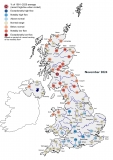Submitted by Gayatri Suman on
Although May was dry and warm overall, it was a month of contrasts. The first half was unsettled, bringing strong winds and rainfall (including some intense localised downpours that led to severe flash flooding) especially in southern Britain, continuing the wet theme of the previous spring months in the south. From mid-month, sustained anticyclonic conditions brought a decisive change: the latter half was sunny, dry and increasingly warm. Correspondingly, soil moisture levels declined (with reports of wildfires in upland areas in Scotland, Wales and the Pennines late in the month), river flows receded sharply, and groundwater levels declined in some more responsive boreholes. Across the north and west, May average river flows were notably or exceptionally low in many catchments. In contrast, healthier river flows and groundwater levels in southern England largely reflect the wetter preceding winter and spring months – much of 2023 has seen a reversal of the usual northwest-southeast rainfall gradient. At the national scale, reservoir stocks for the end of May were moderately below average but decreasing stocks in many northern and western reservoirs led to more pronounced deficits (e.g. Daer was 15% below, Derwent was 20% below). While stocks increased at Colliford and Roadford they remain 17% and 16% below average, respectively. Following the intense late May drydown (which continued and intensified in early June) there is an increased risk of environmental and agricultural stress entering summer, especially in northern and western areas where river flows are low, and where current Outlooks suggest low flows are likely to continue into the early summer. The wet spring means the water resources situation in the southeast is relatively favourable, but vigilance will be required as evaporation rates climb.



